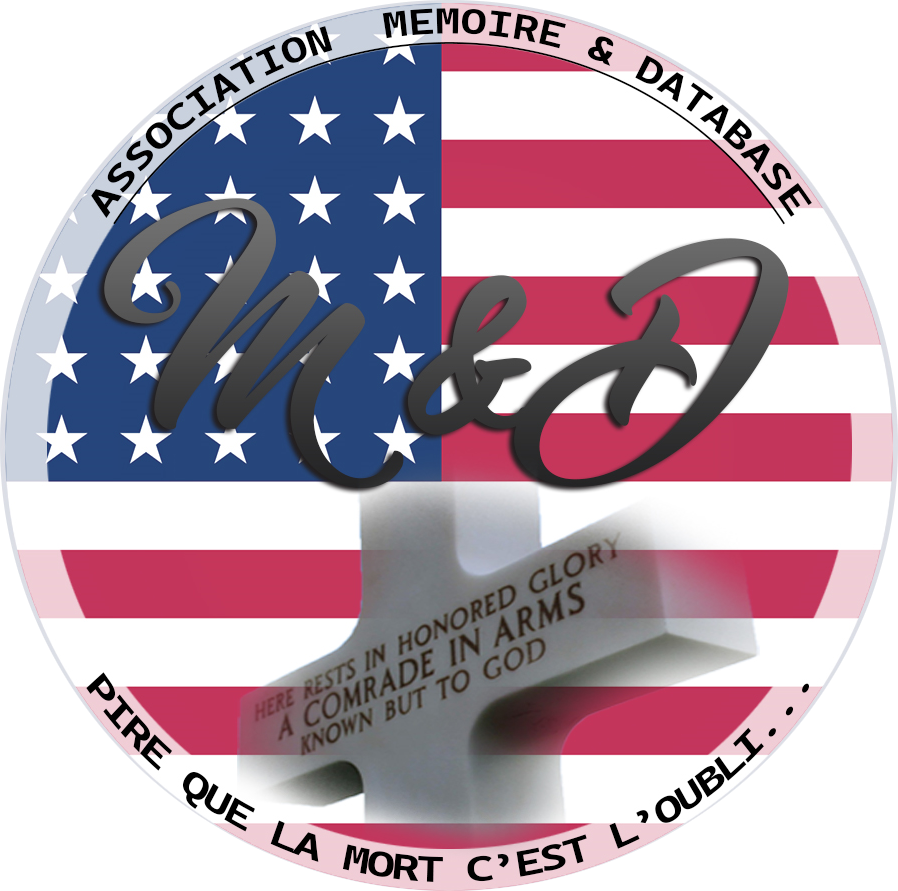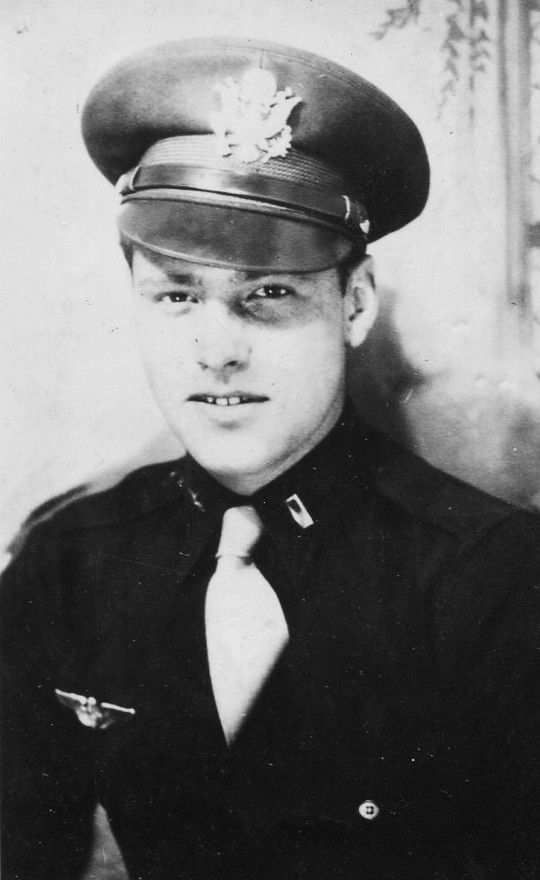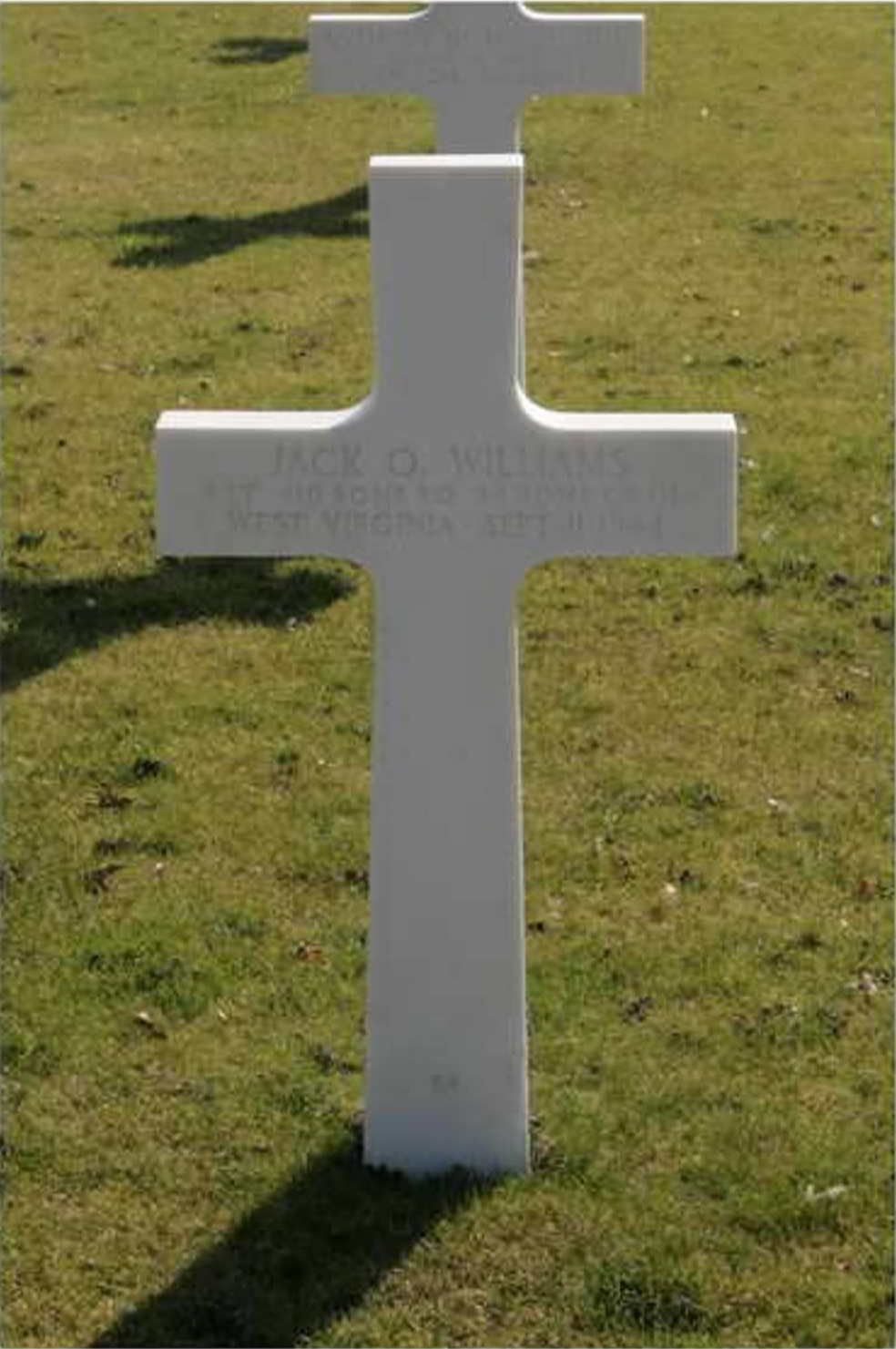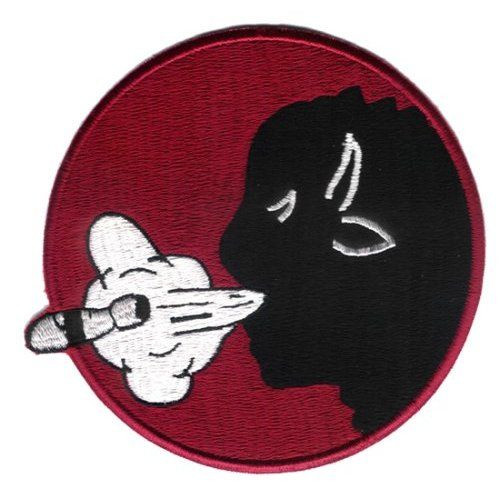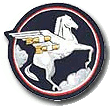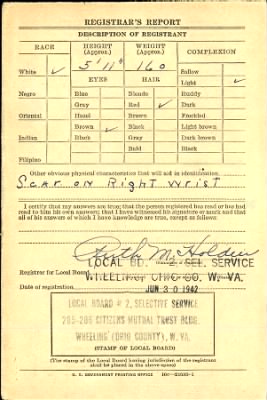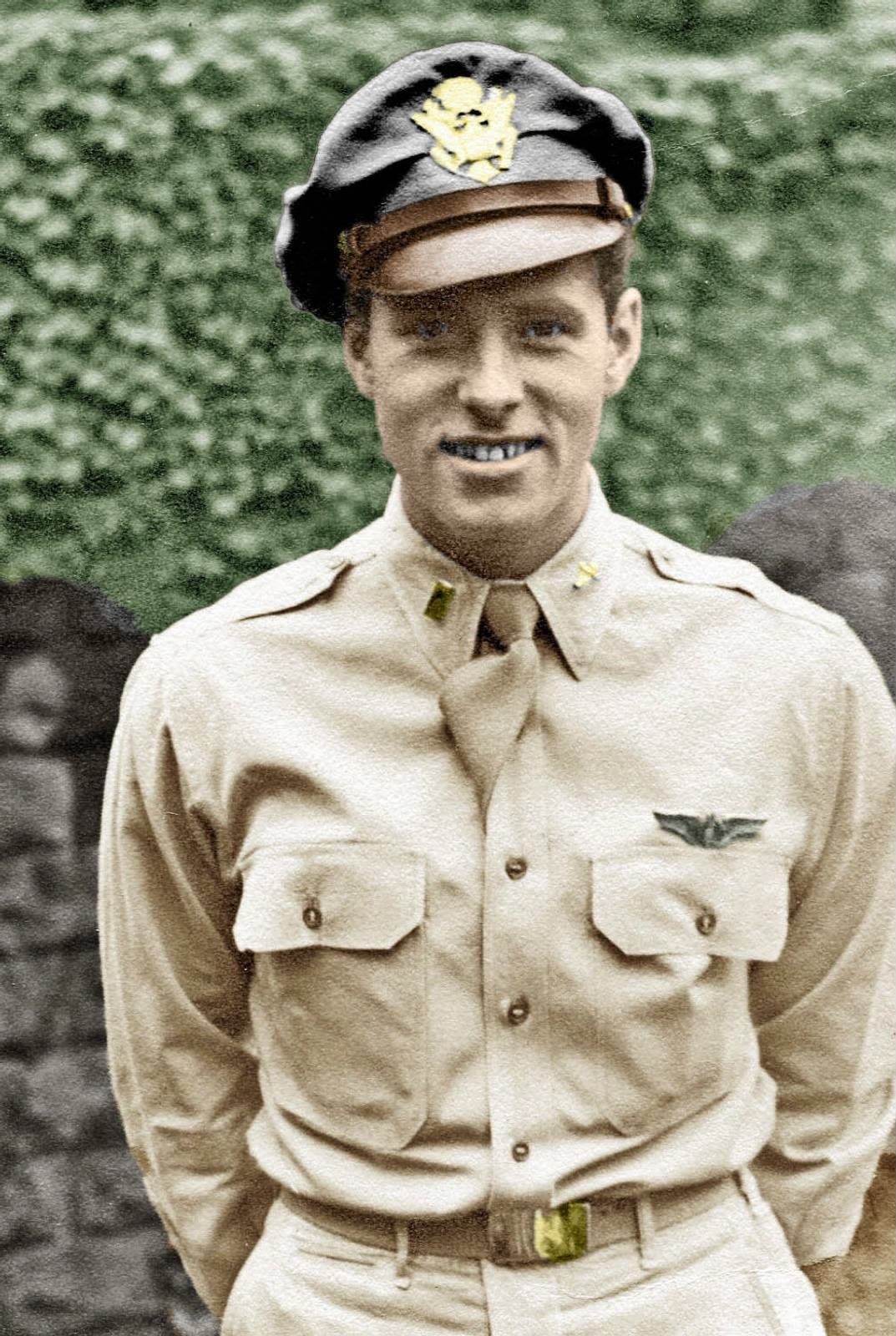|
Jack Oswald WILLIAMS
| |||||||
|---|---|---|---|---|---|---|---|
|
Source : Americanairmuseum.com
| |||||||
| NUMBER OF SERVICE | O-718039 | ||||||
| AGE | 22 yo | ||||||
| DATE OF BIRTH | 4 January 1922 Pittsburgh, Allegheny County, PENNSYLVANIA | ||||||
| ENLISTMENT STATE | WEST VIRGINIA | ||||||
| FAMILY | Mother : Carrie WILLIAMS | ||||||
| RANK | Second Lieutenant | ||||||
| FONCTION | Bomber | ||||||
| JOB BEFORE ENLISTEMENT |  | ||||||
| DATE of ENLISTEMENT | 1942 | ||||||
| SQUADRON | 410th Bomber Squadron | ||||||
| GROUP | 94th Bomber Group, Heavy | ||||||
| ARMY | 8th US Air Force | ||||||
| DATE OF DEATH | 11 September 1944 |
Source : Dominique Potier | |||||
| STATUS | KIA | ||||||
| PLACE OF DEATH | Lieblos, GERMANY | ||||||
| DATA PLAN |
B-17 "Flying Fortress" 42-31653 " Green Hornets "
Take off from Rougham Airfield Mid-air collision with severely damaged nose # 42-97153 (94BG), crashed in Lieblos, west of Gelnhausen, Germany | ||||||
| CEMETERY TEMPORARY | CEMTERY TEMPORARY of Lieblos (GERMANY) | ||||||
|
CEMTERY TEMPORARY of Saint-Avold N°3574 | |||||||
| CEMETERY | ARDENNES AMERICAN CEMETERY and MEMORIAL Neuville-en-Condroz, Arrondissement de Liège, Liège, BELGIUM | ||||||
| GRAVE |
| ||||||
| DECORATION |
| ||||||
| |||||||
| STORY | |||||||
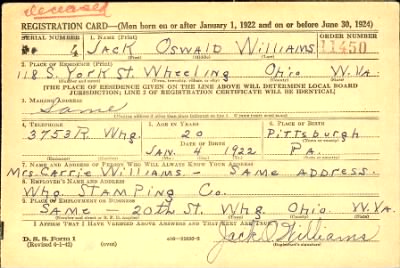 | Source : Justin Burke | ||||||
By : Justin BURKEFriedrich Griessman stood among the small band of men, civilians fetched from nearby Lieblos, who had gathered over a shallow rut that had been dug two days before between the rail tracks and the border of Karl Koch's cornfield. For a moment the solemn group lingered over the hole before reaching down to carefully lift a form from the depression, a cascade of fresh dirt tumbling off of the object. Gripping the load, the men stumbled from the field before muscling the weight up the slight rise of the railway embankment where, at the berm, locals had gathered to watch the proceedings. As the form was placed into the back of a worn wooden cart, the crowd converged. Some of these Germans whispered in low tones and, after getting a look into the rear of the wagon, many recoiled from the disturbing sight. Some appeared burdened after setting eyes on the figure before turning away disheartened and in shock. Others worked to quickly usher off confused and stupefied children who had sprinted to the scene on the outskirts of their small village hoping to catch a glimpse of this "terrorflieger" (2). In the bed of the cart lay the charred body of 2nd Lieutenant Jack Williams. The handsome twenty-two-year-old bombardier, hailing from the Appalachian foothills of West Virginia, had volunteered for the United States Army Air Forces in 1942, during a time when the nation's immature and inexperienced aerial arm was still trying to find it's footing in the air war over Western Europe. Like so many other idealistic, adventurous young American men of his generation, Williams had not only been caught up in the intrigue and romanticism of the "Golden Age of Flight" but, following the attack at Pearl Harbor, felt obligated to join in the fight. At "bombardier college" Jack and his peers mounted towers of scaffolding and were wheeled along through simulated bomb runs in hangers as they learned how to master the tools of their deadly trade: the top-secret Norden bombsight, one of the first optical-mechanical analog computers. This was also where they were expected to develop the "pickle barrel" bombing skills necessary for high-altitude daytime strategic bombing; a theory adopted by the Americans, chastised by the British, and currently being tested and hotly debated among Allied bomber command. In combat the difference between striking an aircraft manufacturing center, vaporizing enemy soldiers huddled low their trenches, knocking out a U-boat pen, wrecking a rocket site, rendering a fuel production plant out of service, and wiping an entire village off the face of the earth would be wholly dependent upon Jack's focus, technique, and competence. Amidst many long, stressful hours of didactics, the students took to the skies in twin-engine trainers where they practiced their trade by killing the large, evil, white chalk circles spread along the training ranges with salvos of sand-filled bombs. After racking up enough points over the eighteen-week program, Jack graduated with the coveted wings of an airman and a commission as a second lieutenant. He was now only a few short months away from being sent to deliver thousands of pounds of high-explosive ordnance upon the enemy from one of the most destructive and technologically advanced weapons of the era. | |||||||
| Source : Justin Burke |
| ||||||
Source : Justin Burke
|
Only a few months after the conclusion of "Big Week" in the last days of February 1944 where Allied bombing operations had targeted Germany's war industry and attempted, unsuccessfully, to fully neutralize the Luftwaffe, Lt. Williams was ordered to the combat crew assembly center at Drew Army Airfield in Tampa, Florida. There he would meet the nine, specialty-trained men who he would go into combat with aboard what would be one of the most famous and beloved war machines in history; the B-17 "Flying Fortress". At the conclusion of combat crew training at Tampa, Jack and the crew dispersed back to their hometowns for a short visit with their loved ones before they were to be deployed to some still-unknown area of operations. Not long before, Jack had deployed on the football fields around Wheeling, West Virginia where he ran track on his high school's squad. Among other subjects, he took French, most likely an attempt at impressing a few fellow students of the opposite sex. However, by July 1944, the young man would be donning the dapper uniform of a U.S. Army Air Forces officer, preparing to dodge flak instead of linebackers and attempting to outrun enemy fighters instead of varsity track sprinters. The visit was bittersweet as all too soon a proud Carrie Williams, Jack's mother, was soon waving goodbye to her boy through tear-filled-eyes as she watched the young bombardier roll out of the train station, off to war. Unbeknownst to her, these would be the last moments that Mrs. Williams would have with her son as in little over a month's time Lt. Williams would bleed to death on the cold floor of his bomber on a mission high over Germany.Just past 1400 hours on the 11th of September, 1944 a B-17 from the 94th Bomb Group based out of Rougham Airfield in Suffolk, England crashed in a field outside of the small village at Lieblos, Germany. Upon grinding to a stop, a fire had lit off in the aft section of the aircraft, and the surviving crewmembers, severely wounded, disoriented, and seeing the need to get far away from the fuel-laden, broken bomber, hastily abandoned the Fortress, leaving behind the body of their dead friend, Lt. Williams, which had become entangled in the wreckage. The men limped away from the bomber and collapsed alongside the railway embankment that bordered the cornfield. With their ship aflame and smoking behind them, the band of shaken bomber boys quickly realized that they were being watched (12). | ||||||
Since late spring 1944 on an ever-increasing basis and in overwhelming force, the community of Lieblos had watched American bomber streams streak across the sky above them, heading off to deliver their deadly cargo deep into the Reich. The raiders usually arrived late in the morning, passing overhead in massive formations only to return a few hours later, lightened of their tonnage, and headed back to England. Unlike the Luftwaffe "hunters" that buzzed in and out of the nearby airfield seeking refuge or fuel, the locals had never seen one of these giants up close but today, with the sudden arrival of the Boeing, and the Americans within, they would flock, excited and intrigued, to the site of the crash. After witnessing the bomber descend, Gerhard Solzer climbed on his bicycle and rode to the outskirts of town, chasing after the smoking B-17 as it coasted over the village. The fifteen-year-old was one of the first to arrive at the embankment where he then climbed the gentle hill to witness the scene unfolding before him. Positioned over the field, he watched from "Out of the smoking aircraft climbed 4 or 5 American flyers in fur jackets and big boots" (14). A small group of locals began to gather, alerted after hearing the four-motored American war machine echo down the Kinzig Valley before passing over their quiet, picturesque village and landing in the fields to the west (15). For many Germans, many of whom National Socialism had been pressed upon them, the unrelenting, round-the-clock bombing raids by U.S. and British Air Forces were taking a great toll on the civilian population. Fueled by the destruction of R.A.F.'s controversial fire-bombing raids on the populace of cities like Hamberg and reinforced by effective Nazi propaganda campaigns denoting American fighter pilots and bomber crews as nothing more than murders of women and children, the frustrations of many German civilians began to boil over. In the fall of 1942, Adolph Hitler had openly approved the extermination of Allied "terror and sabotage troops" (16). One year later, S.S. Reichsfuhrer Heinrich Himmler issued orders restricting local police units from intervening with any retribution by the populace towards any captured "terror fliers".(17) In May of 1944 both propaganda minister Joseph Goebbels and Hitler's deputy, Martin Borman, blatantly encouraged vengeance, or "lynchjustiz", and, in some instances, permitted on-the-spot executions of downed American and British fliers. Reports show that, between August and October of 1944, incidences of violence against and murder of Allied aircrewmen at the hand of German civilians would spike. (18) These occurrences, while tragic and not to be discounted or condoned by any means, were far from the norm for most Germans. The atrocities that did occur, while understandable, can be better understood given the extreme circumstances at hand. As is the unfortunate reality of war, examples of barbarity and cruelness can be found perpetrated by all parties and by both sides. Such examples are not unique to a nationality, of course, but are a consequence of the desperate circumstances and the passions of war. U.S. airmen, newly arriving in England in 1943 and `44 were given lectures about escape and evasion techniques that included what to expect from the civilian populace in the countries where they would be operating. "We were told that we weren't going to be treated too well", chuckled one former bombardier with the 94th Bomb Group as he reminisced on his indoctrination to the warzone. (19) Additional rumors, some greatly exaggerated, spread through the combat crew's Nissen huts regarding the supposed wide-spread disdain that the Germans had for American fliers. Reports of lynches, executions, and even torture at the hands of angry mobs were rampant leaving many downed U.S. airmen to purposely seek out refuge with the Wermacht when confrontations with hostile citizenry manifested. In response to the reports, some of which were unfounded but many confirmed, the combat men were instructed to avoid German civilians in all cases. As an additional precaution, many bomb groups issued sidearms for the crews to carry on their missions to utilize not necessarily in event of a shootout with the enemy, but more likely to be used when a challenging civilian, armed with a pitchfork or hunting rifle, may need some discouragement. When the group of locals from Lieblos crested the rise that ran along the rail tracks adjacent to the village they could see that a long scar had been torn in the earth leading to where the giant, broken aircraft had come to a rest on its belly. Below them at the base of the hill, huddled the American "terror fliers"; "air gangsters," clad in their heavy, drab flight gear, bloodied and in pain. It was at this moment when, most vulnerable, helpless, and hurt, that the Germans came upon these intruders (20). The survivors on Lt. Williams' crew were not met with pitchforks or rifles on that Monday afternoon. Instead Germans like Karl Ost, Gerhard and Phillip Solzer, Friedrich Griessman, and many others in attendance that day saw the need to help. As the men assisted one bleeding crewman to a nearby house, Gerhard's mother appeared carrying folds of cloth that she used to bandage the American's wounds. She had retrieved some water from the family's well and handed the shaken boy a cup which he gratefully accepted and guzzled down. Other villagers, none able to speak English, offered comfort to these boys as they tried to recover from the shock of the incredible ordeal they had just survived (21). Without hesitating, Fredrick "Fritz" Griessman, the local cemetery caretaker, had also rushed to the scene of the crash. "After the plane had landed, I went from my house to the plane because I was in the Red Cross, thought I could help, if anyone was wounded" he wrote in a post-war interview with U.S. investigation officials (22). Gerhard Solzer's Father, Phillip, was tending to one of the bleeding airmen as Griessman, assessing the flaming bomber and risking his safety, entered the mangled nose compartment to search for any trapped or incapacitated airmen that may need help extricating themselves from the fiery wreckage. Finding none, "Fritz" retreated from the inferno, joining up with the battered young fliers just in time to watch military trucks, dispatched from the infantry barracks at Gelnhausen, pull up on scene. The soldiers rapidly dismounted, leveled their rifles at the group, pushed the civilians back away from the airmen, and searched the nervous fliers, stripping them of their escape kits. While some soldiers scrambled around the smoldering Fortress attempting to douse the flames that still cooked inside the forward sections, others fanned out, scouring over the countryside to hunt down any other Americans that may be attempting to evade capture. The soldiers returned, empty-handed of any fliers but brandished the Fortress' bombsight. The Norden had been found in one of the surrounding fields after having broken loose of the craft as it maneuvered over the town. Back in the cornfield, the Americans were pulled to their feet and marched to the road where they stumbled up into the back of the trucks before being hauled off to the airfield where they were held overnight. Before leaving the crash site, the soldiers made sure to collect the names of all the hesitant witnesses (23). For Germans citizens, and any peoples who found themselves under Nazi rule, aiding the enemy came at a steep price. In many cases, the offense was considered treason, an act of "defeatism"; a crime against the state. To remedy the betrayal, "vermin" who were deemed guilty of helping the enemy would be dealt with by the ruthless Gestapo or would find themselves being "rehabilitated" at a concentration camp after examination by the State’s much-feared people's court (24). Despite the risk of interrogation, detainment, torture, or worse, those courageous Germans who cared for the rattled, injured American fliers that day knew that they were directly defying the regime. "The inhabitants were fed up with the war in late 1944 and longed for peace", explained Eckard Sauer, local historian and author of the book, Absturz im Kinzigtal: Die Luftfahrt im hessischen Kinzigtal von 1895 bis 1950. (25) "When American troops arrived at the end of March 1945, they were considered by many to be liberators" (26). No doubt, as the people of Lieblos tended to the airmen's wounds, they couldn't help but see the faces of their own sons, many of whom were, at that moment, deployed along the crumbling front lines in Pomerania or France, fighting not for the Fuhrer or the Nazi ideal, but for their country, their families and their comrades. Due to the atrocious brutality and coldness that commonly exists in war, examples of hope and humanity are often overshadowed. The events that occurred on the 11th of September, 1944 along the border of Karl Koch's cornfield were, without a doubt, among the great acts of selflessness and courage of the entire War. Ironically enough and seemingly unfounded, when adapted to English, "Lieblos" translates to "without love". With the departure of the infantry soldiers late in the evening of the 11th, an exciting opportunity presented itself for the local boys; one which they could not pass up. The kids climbed into the wrecked ship and took turns sitting at the controls of the tail guns where they imagined blasting away at enemies in the sky, high above their homes. One of the adventurous youths, Heinrich Goy, decided to explore the rest of the aircraft and maneuvered through the cramped interior to the front of the Fortress where he stumbled across the unforgettable sight of Lt. Williams. "He had been badly injured. Beneath his knees, the bones of his lower legs protruded, and his head was deformed" (27). Goy quickly retreated, scrambling out of the B-17. The sight of the American officer, however, would leave a lasting impression on the teenager; "A terrible sight that I can not forget until today" (28). Luftwaffe salvage teams assumed control of the wreckage at 1800 hours and wrenched the body of Lt. Williams out of the plane. Along with the local police force that had been ordered to keep everyone away from the downed machine, locals somberly watched as the soldiers carried the burnt body of Jack Williams to the edge of the field and set it into a hastily dug hole. Members of the team tossed dirt over the body and returned to their work of searching for any pieces of intelligence that remained in the aircraft. The following day, soldiers arrived at the Solzer house looking for Gerhard's father. As an award for his act of humanity toward the Americans, Phillip had been summoned by the local Luftwaffe intelligence staff for questioning related to his interactions with the enemy. Luckily after a few tense hours of questioning, could not formulate a case of wrongdoing and Solzer was released with a warning (29). It was not until September 13th when the Luftwaffe salvage teams finished their operations and abandoned the crash site. Additional crews wouldn't disassemble the aircraft for a few weeks leaving the local kids in command of the impressive warbird. Dissatisfied at the treatment of the fallen American, "Fritz" obtained permission from the Burgemeister of Lieblos and, after rallying some eager volunteers, recovered Williams' hastily buried body. Greissman brought the officer back to the cemetery where he cleaned the mess of remains as best he could. Besides being charred in the fire after landing, the body showed signs of horrific trauma, the aftermath of events that had proved fatal for the lieutenant while on his mission two days earlier. Those who were able to look upon what was left of the bombardier would report being haunted by the gruesome sight for decades to come. No identification tags were found on the body leaving Griessman to record the unknown airman as "heavy built" and "very tall" (30). After carefully wrapping the lieutenant in clean sheets, the care-taker arranged the remains in a simple wooden casket which he had constructed himself specifically for the stranger. The following day, Griessman and his companions carried the casket to the northern end of the cemetery and gently settled the boy into a freshly dug grave where he could rest in the shade trees overlooking the beautiful rolling fields, mountains, and lush forests surrounding Lieblos. In attendance to pay their respects to the young airman were the Burgemeister and many of the same people who had been witness to the crash, the capture of the crew, and the original impromptu burial. To welcome their new guest, the Germans had chosen to mark the grave of the stranger with a simple wooden cross bearing the inscription "hier ruht ein unbekannter amerikanischer soldat"- "an unknown American soldier rests here" (31). For the next year-and-a-half, Williams would remain in the cemetery, resting in a plot alongside the community's loved ones. Back in West Virginia, the sporadic flow of letters that the Williams family had been receiving from the wayward bombardier since his arrival at some classified location in England suddenly dried up. Late in September, Mrs. Williams received a telegram that she and countless other American families feared the most. Jack was listed as "missing-in-action", lost somewhere in the "ETO"; the European Theatre of Operations; an intimidatingly large expanse indeed. The following weeks were miserable for the family as any additional information was scarce, at best. The communication between the wives and mothers of the boys on the crew was just as frustrating as the status of the men remained a mystery. What was known for sure was that Jack and his brothers-in-war had disappeared over hostile territory, somewhere on the other side of the world. Confirmation of the horrible reality of Jack's death finally reached the Williams' weeks later as letters, sent from the survivors on his crew, who were then being held in German prisoner camps, began to trickle in to the homes of their loved ones. As these men attempted to describe the events that led to their downing, capture, and the death of their dear friend, word of Jack's demise was sorrowfully passed on to his family. To make matters worse, the whereabouts of the Williams boy's body was unknown, although the War Department assured his heartbroken mother that a "continuous and intensive search is being made of the area where your son died" (32). However, as the agony of week after a week turned to months with no further word, the Williams family, distraught and still in shock, was beginning to believe that Jack may be lost for good. Three months after the end of hostilities in Europe in August of 1945, a box arrived at the Williams home containing Jack's personal belongings, recovered from his barracks at Rougham in the days following the crew's failure to return. The items had been kept in storage until the Army finally arranged to get his belongings back to his next of kin. The package contained two shirts, two woolen trousers, one service cap, two belts, four undershirts, a dozen pairs of socks, one pair of boots, a few photographs, a handkerchief, one sewing kit, a worn New Testament, a pair of flight wings and three checks totaling $204.04. All that Mrs. Williams noticed, however, was the faint smell of her son (33). In February of 1946, the 48th Quarter Master Graves Registration Service (QMGR) was assigned the task of looking into rumors that had emerged regarding the location of the body of an American airman that had disappeared within their area of responsibility nearly a year-and-a-half earlier. (34) After piecing together captured German reports and sifting through piles of records recovered at War's end from Dulag Luft, the infamous German interrogation and processing center for captured Allied air personnel, the trail led the 48th to a cemetery in a small village in central Germany. Led on by helpful locals, the soldiers were directed to a grave marked with by a simple, weathered wooden cross. After nearly breaking their shovels, along with their backs, on the frozen ground, the unit unearthed the shattered skeletal remains of an individual resembling the description noted in their reports. Satisfied with the discovery but unable to confirm the identification due to the state of decomposition of the remains, the body was shipped to the U.S. military collection site at St. Avold, France where the mysterious occupant would be housed while the investigation into his identity continued (36). Unfortunately, when compared to the lieutenant’s medical file, Army doctors were unable to confirm that the skeleton was that of Jack Williams. It would seem that the identity of the “soldat” would remain a mystery. For nearly three years Army investigators sorted through stacks of misleading reports concerning isolated graves of Allied airmen spread all across central Germany attempting to establish the fallen airman's identity. Interviews from the surviving members of Lt. Williams' crew had finally been organized as QMGR field units continued to work diligently to track down eyewitnesses from Lieblos and the surrounding areas who had seen the landing or been present during the recovery or burial process. The investigators first visited "Koch's Acre" and then Gelnhausen Airfield but were unable to find any sign of the aircraft, which had long been repurposed as scrap in the months after the crash. While the Burgermeister could not be located, numerous residents, including the Solzers and Friedrich Greissman, were happy to assist the Americans and participated in interviews to give their accounts describing the events surrounding the arrival of the aircrew on that exciting day in mid-September of 1944. In addition, the personal journal of a local policeman who had been tasked to watch over the crash site in the days following the landing had been located and provided a final piece in helping to solve the mystery of the unknown airman. (38) On October 24, 1949, more than five years after Jack had been lost in Germany, Carrie Williams received word that her son's body had been found. When given the option of having the young lieutenant returned home to Wheeling, Mrs. Williams instead chose to have Jack's body remain in Europe to be memorialized with the thousands of other American husbands, brothers, and sons who had fallen in battle in Europe (39). So in the summer of 1950, Jack was, once again and for the last time, moved and reinterred. This time he was transferred to the Ardennes American Cemetery and Memorial, recently established for U.S. servicemen at the village of Neuville-en-Condroz in Belgium. Lt. Jack Williams still rests at Ardennes American Cemetery and Memorial in plot C, row 38, grave 14, "side by side with comrades who also gave their lives for the country" (40). The story of 2nd Lt. Jack Williams is only one of the incredible stories explored in the upcoming book, Of Good Courage, by Justin Burke. To find out more about Williams and the "Green Hornets" crew visit www.Facebook.com/OfGoodCouragebook or email the author at This email address is being protected from spambots. You need JavaScript enabled to view it. | |||||||
|
Crew of B-17 "Flying Fortress" 42-31653 " Green Hornets "
| ||
|---|---|---|
| Merle GREEN | Pilot | Prisoner |
| Irving METZGER | Co-pilot | Prisoner |
| Frank JONES | Navigator | Prisoner |
| Jack WILLIAMS | Bomber | Dead |
| Lou LEHERE | Flight engineer/top turret gunner | Prisoner |
| George OSTROWSKI | Waist gunner | Prisoner |
| Jim GEGENHEIMER | Ball turret gunner | Prisoner |
| Pete RILEY | Radio Operator | Prisoner |
| Sid HATFIELD | Tail gunner | Dead |
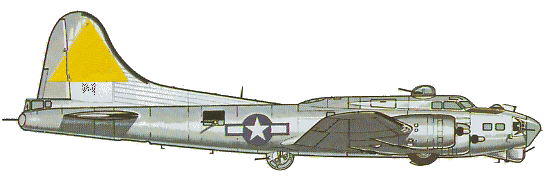 | ||
| SOURCE INFORMATION & SOURCE PHOTO | Justin Burke - Abmc.gov - Findagrave.com - STAR Corps (StoryTelling And Research) WWII Fallen - Fold3.com |
|---|---|
| PROGRAMMER | Henri, Garrett, Clive, Frédéric & Renaud |


